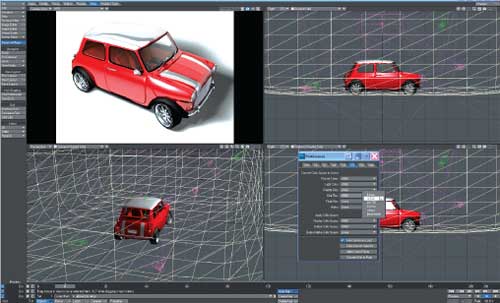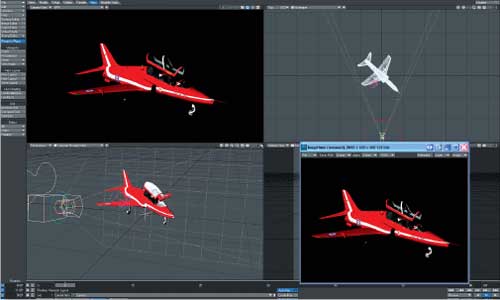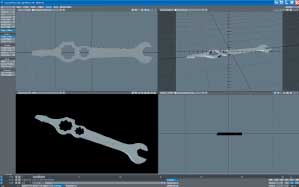Latest News
June 1, 2011
By Mark Clarkson
NewTek hasn’t released a new LightWave since version 9.6, way back in January 2009. (See DE’s October 2009 review.) Given the amount of intervening time, though, version 10 seems a little light on new features.

In addition to working with LightWave’s Layout VPR window (top right),
users can set up LightWave’s linear colorspace workspace (bottom right).
Unlike almost every other 3D program, LightWave divides modeling and rendering into two separate applications, called Modeler and Layout. LightWave has long been criticized for this fragmentation of the application “but personally, I like it, as it allows me to focus on modeling when I’m modeling, without worrying about everything else in the scene.
If there are any major changes in Modeler, I couldn’t find them. There has been some welcome tweaking of the interface, such as the addition of buttons for some common operations: inserting layers, for example, and moving and copying objects between layers.
Layout also sports little touches that are easy to overlook at first glance. Some tabs have been renamed or moved around, some buttons have been added. Numeric input fields have been given new slider controls.
The renderer itself appears to be the same. An admittedly unscientific selection of test renders all showed the same results as version 9.6, completed in the same times.
VPR is the Star
LightWave 10’s most obvious improvement is Layout’s new real-time Viewport Preview Render (VPR). Unlike LightWave’s existing VIPER preview, which ignores many compositing and lighting effects, VPR uses LightWave’s actual renderer: You see all the fur, fog, reflections, motion blur and volumetric lighting effects for a very accurate preview of the final render.
Here’s where compute unified device architecture (CUDA)-enabled applications have really spoiled me. My Quadro 5000 has 3.5 gigs of high-speed RAM and 352 processors cores, and LightWave doesn’t seem to be utilizing it effectively for VPR, relying instead on my CPUs to do much of the heavy lifting. Consequently, VPR is nowhere near the speed of, say, Bunkspeed SHOT (see my January 2011 review). Your results may vary. Demos I’ve seen running on Windows 7 and i7 processors were much speedier. My graphics card is hot, but my computer and operating system are, admittedly, pretty creaky. (I’m still running XP on a scant two cores).

LightWave 10’s VPR preview, top left, uses the actual renderer to produce
accurate previews of your finished renders (bottom right).
VPR doesn’t really let you interact with the render. You get no feedback on what it’s doing. You can’t focus in on a particular area. VPR also isn’t very “smart” about when it needs to restart a render “opening a panel on a different monitor, or opening a non-overlapping window, for example, will often trigger an unnecessary redraw.
Linear Color Space
One of LightWave’s most significant new features “its new linear color space workflow “is invisible at first.
Dealing with color spaces can be a pain, but it’s a crucial part of producing photorealistic renders. You might have texture images coming in in one color space, a monitor displaying in another color space and, under the hood, the renderer itself working in yet another color space. The upshot is a lot of extra work to get your final images to look the way they ought to look “and they never really do look quite the way they should.
 The VPR window in LightWave’s Layout interface, bottom left, provides a real-time preview of the render. |
The big problem is gamma. A gamma curve, applied to an image, affects the brightness of that image’s pixels, bringing it more closely in line with the way our eyes perceive those colors. These curves are embedded in most image files “and most monitors, as well “but they’re typically ignored within the renderer itself. In other words, you’re not using the images you think you are, and you don’t get the results you expect. You end up turning up the lights, over-cooking reflections and specularity, or applying gamma correction to the final render.
LightWave 10 makes everything a whole lot easier with its new linear color workflow. All images are converted to a linear color space internally, where the renderer does all its work with them. The gamma curves are baked in, so that the renderer sees your textures the same way you do. Renders are converted back to the color space of your monitor or other devices.
FBX / Collada / MDD
LightWave 10 improves the program’s handling of several interoperability file formats.
LightWave 10’s FBX performance is much better than 9.6’s. Geometry now loads properly instead of scattering pieces through the scene. The resulting objects in LightWave are better organized.
I had less luck with textures, though. Image maps, colors, specularity settings and so forth were often ignored or assigned someinteresting numbers. (Glossiness = 393.2132%?) To be fair, moving complex files from one application to another rarely goes smoothly without first spending time and effort on tweaking your pipeline. LightWave isn’t alone here, and it’s much improved from previous versions.
I ran into a couple of new bugs in LightWave’s Collada import and export—which worked pretty well for me in the previous version “but Newtek assures me that they’ve now been fixed.
LightWave’s MDD format now supports Autodesk’s geometry cache. MDD files are used primarily to move motion files around from motion capture and character animation—not something most of us do very often.
Dude, Where’s My CORE? In going through the list of new features in LightWave 10, you’ll note that a few of them—such as a new rigid body dynamics system and new UV mapping tools—are actually available only in CORE, which is still in beta at the moment. Its release seems imminent, but it’s been that status for a while now. Bits and pieces of CORE technology have shown up in LightWave 10, however: VPR and the new linear color space are the most noticeable of them. If you purchase LightWave 10 now, you get access to the CORE beta program, as well as a copy of CORE when it releases later this year for no extra cost. |
Virtual Studio, 3D Mouse Support
LightWave 10 adds support for 3Dconnexion’s 3D mice—in Layout, at least. It has also added support for the InterSense VCam virtual camera rig. In combination with VPR, the new Virtual Studio tool allows you to create a virtual set. The director can move his virtual camera around a real space and see the results instantly mapped to a virtual space in real time. While undeniably cool, this is more useful in motion picture and TV production than industrial design.
Documentation
Are there more new features hiding in LightWave 10? Probably. Features are no good to me if I can’t find them, can’t figure out how to use them, or don’t know they exist in the first place.
Which brings us to the documentation. Brace yourselves.
Let’s say you want to know how to implement bones. Bones do what you’d expect: Create a posable skeleton within an object for use in deforming it. So you press F1 to fire up the help system.
There’s nothing in Contents about bones unless you drill down a ways “and you have to know where to drill down.
Do a search on “bones,” and you’ll get a list of every section that contains that word. The potentially useful “Add Bone” appears at the top of the list, through alphabetical serendipity rather than any rational ordering. The list also includes Display_Options, Navigate_Tab and Vertex Paint.
Search for “radiosity,” and you’ll get a confusing list ranging from Basic Light Attributes “which sounds promising, but doesn’t actually contain any information on using radiosity “through an alphabet soup of Greek: Delta, Kappa, Sigma, Theta. Here’s a hint: You actually want to open the Global Illumination tab from the Render Globals panel.
The discs include the actual program manuals in PDF form. However, entire sections are missing or referring to the wrong version of the program.
LightWave actually has a shallow learning curve, but you’d never know that from the documentation, which leaves you chasing your tail forever over the simplest tasks. I gave up and relied on Google and Internet forums.
Conclusion
This may seem like a negative review, but I like LightWave 10. I really do. Its renderer is first-rate, right out of the box with real-world lights and lenses, a nodal shader and, in this version, VPR and linear color workflow. LightWave’s animation capabilities are probably well in excess of your needs, unless you do actual character animation. Plus, at $895, it’s a bargain. Upgrades start at $495. There’s just a little less new stuff to like than I was expecting “and some of the old stuff, especially the documentation, is getting downright decrepit.
I like the LightWave modeler bit, but because the majority of NewTek’s R&D is going into Layout (and the development of CORE), Modeler is languishing. At this point, modo is a better LightWave modeler than LightWave. If you use LightWave primarily for creating geometry, there’s no compelling reason to upgrade from 9.6 to 10.
If you’re using LightWave to create final beauty shots, then VPR and the linear color workflow are worth their weight in gold. Download the free trial at NewTek.com/lightwave/lwtrial.php and give it a go.
Mark Clarkson is a Wichita, KS-based writer. He can be reached at [email protected].
Subscribe to our FREE magazine, FREE email newsletters or both!
Latest News
About the Author
Mark ClarksonContributing Editor Mark Clarkson is Digital Engineering’s expert in visualization, computer animation, and graphics. His newest book is Photoshop Elements by Example. Visit him on the web at MarkClarkson.com or send e-mail about this article to [email protected].
Follow DE





